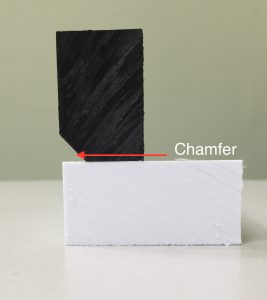If you’re reading this post, you probably already know that Plastic Concepts can make just about anything out of plastic, but focuses on creating products for laboratories: tanks of any size or shape, cabinets, carts, rolling carts, totes, pass thru’s for cleanrooms, fume hoods, changing stations and lockers… you name it, we can probably do it.
Fabricating with plastic is a lot like working with wood or metal — you measure, cut, mill, and put pieces together. One main difference here (other than the material) is the Plastic Weld.
I’m sure you thought welding was just for metals, right? It is a similar process, although, while welding with metal requires an electrical arc to adhere the surfaces together, the plastic welding process uses hot air and gases to heat and seal the plastic together.
So, the plastic weld, at first impression, seems simple. You have a gun that heats air or nitrogen, and the plastic welding material is fed through and adheres to whatever you’re working on.
But it’s much more than that – not all plastic welds are created equally. It takes experience, patience, a steady hand and focus, to get it right. And getting is right is what sets Plastic Concepts apart!
Understanding the material you’re working with*, the correct temperature and air pressure, the manner in which you feed the welding material through the gun, the gas that you use and the rate at which you do it all can make or break the fabrication. It takes at least a year to get good at it.

Some projects, like our large chemical storage tanks, for example, require stronger welds, and therefore a deeper chamfer. What’s a chamfer, you ask? The best way to describe it, is that it’s a 45-degree “gutter” that is cut along the edge of the plastic material. It’s cut onto the edge that will be affixed to the other piece, which is just a flat edge.
The larger the chamfer, the more welding material you use, and therefore the stronger the weld — each weld actually becomes stronger than the material itself. The chamfers that we cut for storage tanks (and certain other applications) are deep – we take out 2/3’s of the material so that we have the space to fill it in with welding material.
We lay down about 8-10 welding strips in each chamfer compared to the standard 2 or 3 strips and the more welds, the stronger the adhesion — and strong welds are everything! Especially in laboratories. Our tanks hold some awful chemicals and we are confident that when the tanks leave our shop they are ready for the job.
More about finishing, standard welds, the tri-tip weld, temperature and gas in future blog posts.
*Plastic Concepts works with many different types of plastic material:
- Polypropylene – perforated sheet
- Acrylic (Plexiglass)
- Lexan (Polycarbonate)
- Teflon
- PFA
- FRPP Flame Retardant Polypropylene (FM4910)
- ABS
- CCP7-D Flame Retardant
- CPVC (Corzan)
- Delrin
- HDPE/LDPE
- Halar
- Kydex
- TFE
- PET
- PVC
- PVDF (Kynar)
- PTFE
- UMHW


Leave a Reply